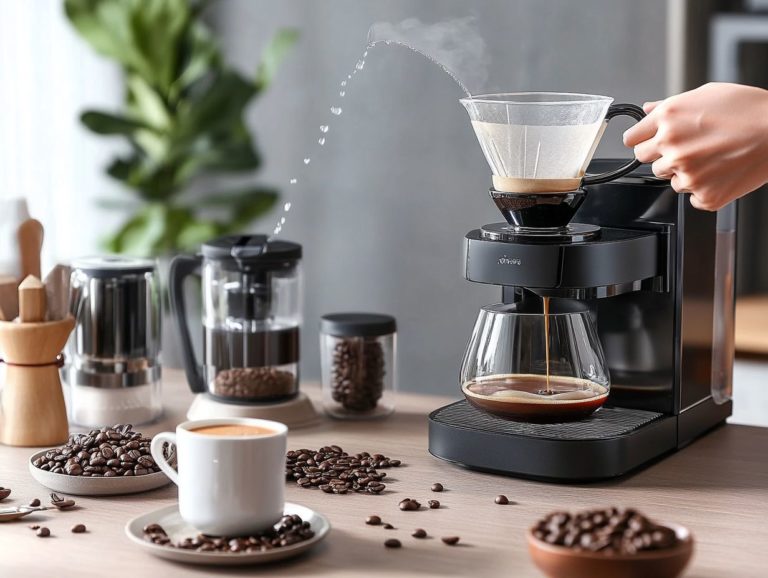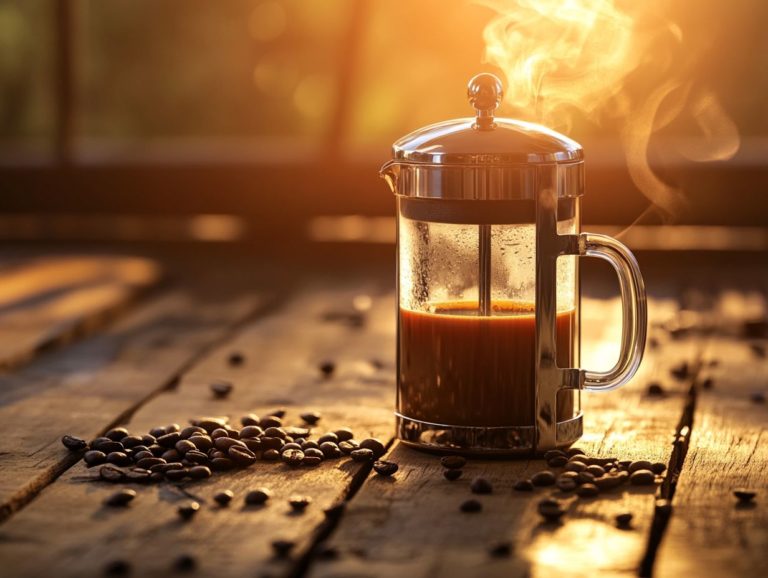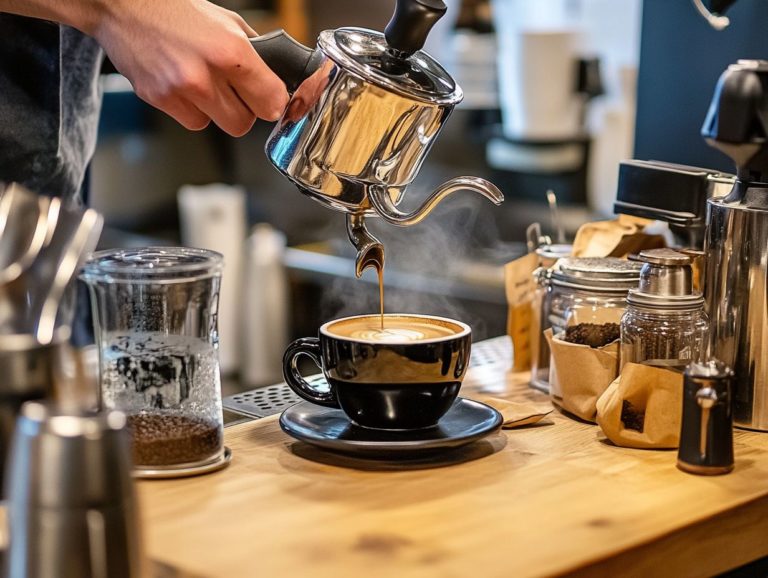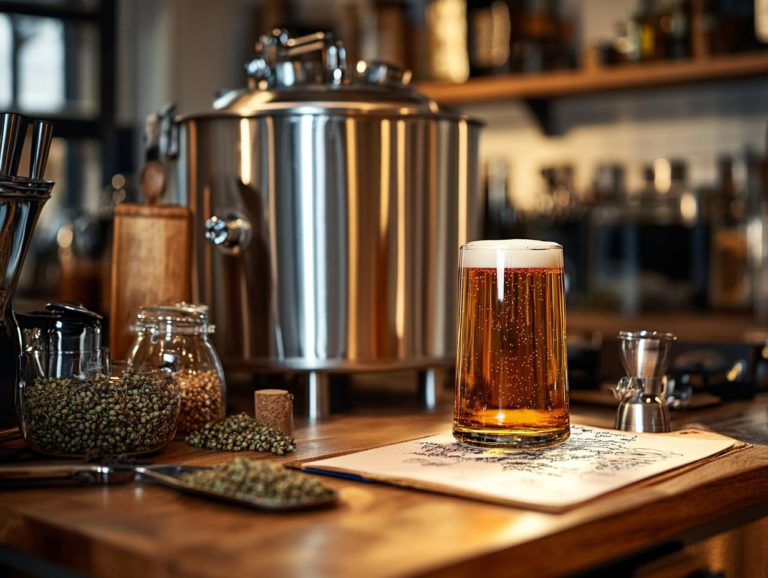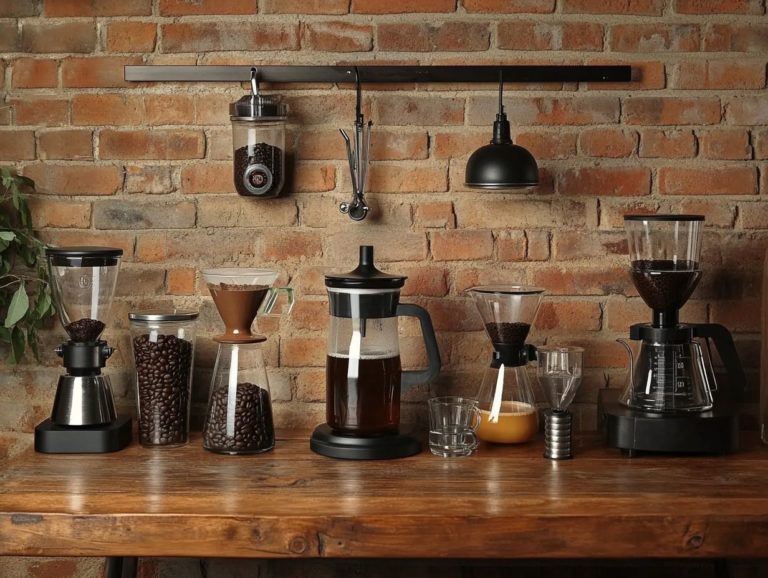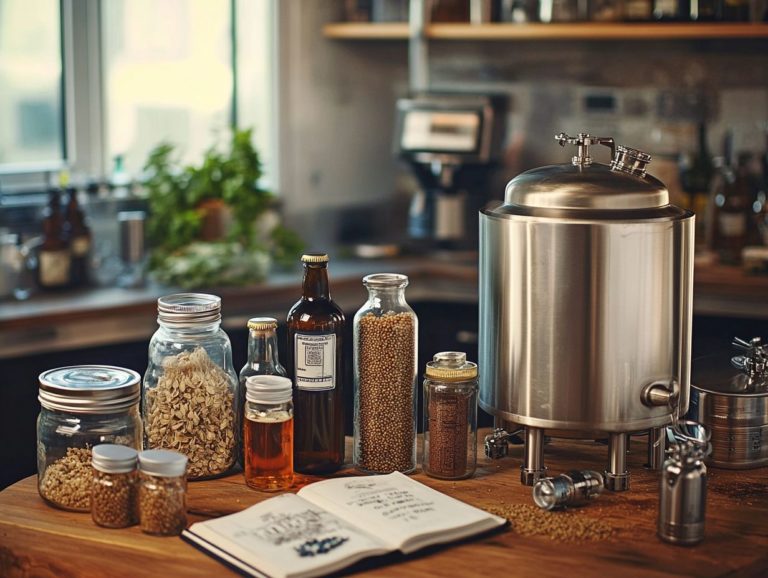How Brewing Method Influences Coffee Strength
Coffee enthusiasts often embark on a quest for the perfect cup. But what truly defines its strength and concentration?
Several key factors contribute to the strength of your coffee, including the roast level, bean type, and grind size. The brewing method you choose whether it’s drip coffee, French press, or espresso also plays a significant role in shaping the final brew. These brewing methods significantly affect the Total Dissolved Solids (TDS), which refers to the concentration of dissolved substances in your coffee, and other chemicals in your coffee.
Water temperature, brewing time, and agitation also affect the outcome. There are various tips to help you adjust the strength according to your preferred method.
Get ready to transform your coffee experience and brew your best cup yet!
Contents
- Key Takeaways:
- What Determines the Strength of Coffee?
- How Does Brewing Method Affect Coffee Strength?
- Coffee Brewing Methods
- What Other Factors Affect Coffee Strength?
- Unlock the Secrets to Brewing the Perfect Cup of Coffee
- How to Adjust Coffee Strength for Different Brewing Methods?
- Conclusion
- Espresso Preparation
- Frequently Asked Questions About Coffee Brewing
- How does the brewing method influence coffee strength?
- What is the strongest brewing method for coffee?
- Does the type of coffee bean affect the strength of coffee?
- How does a cold brew method affect coffee strength?
- Can the same brewing method produce different strengths of coffee?
- What is the recommended coffee to water ratio for a strong cup of coffee?
Key Takeaways:
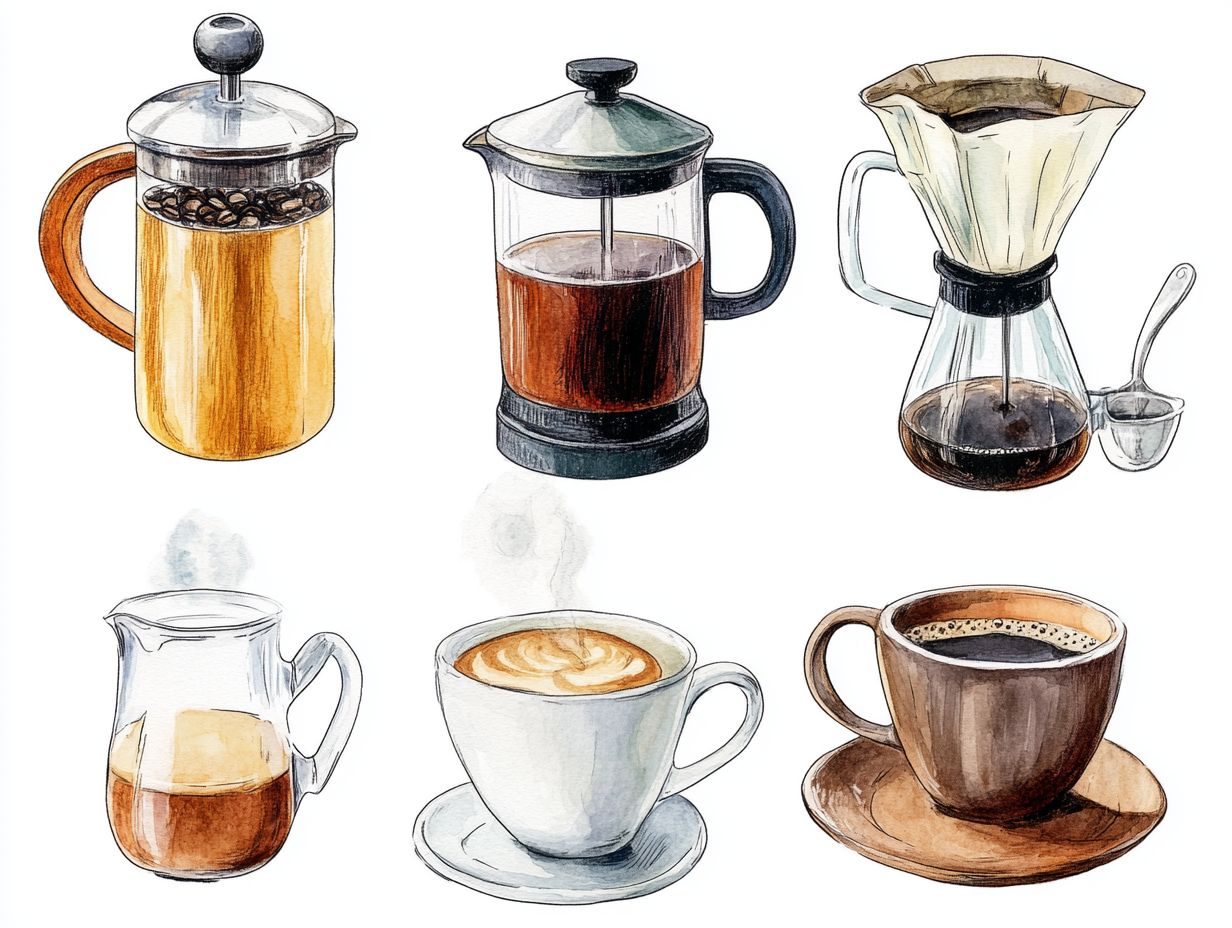
- Brewing method plays a crucial role in determining the strength of your coffee, influencing the concentration and extraction of flavors.
- Different methods, such as drip coffee and espresso, produce varying levels of strength due to factors like water ratio, brewing time, and grind size.
- To adjust coffee strength, consider factors like grind size, water temperature, bean freshness, and the specific brewing variables for optimal results with your chosen brewing method.
What Determines the Strength of Coffee?
The strength of your coffee hinges on several key factors, including the brewing process, the type of coffee you choose, the grind size, and the water-to-coffee ratio. Each of these elements plays a vital role in extracting soluble compounds and insoluble particles from the coffee grounds, which in turn shapes the flavor profile, body, and overall intensity of your brew.
Striking the right balance in extraction is essential for amplifying the aromas you love while keeping bitterness at bay, allowing you to savor the perfect cup of coffee crafted precisely to your taste. Understanding the extraction process can help achieve this ideal brew.
1. Roast Level
The roast level of your coffee plays a crucial role in determining its strength, influencing not just the flavor but also the caffeine content, TDS, and body of the brew.
Each roast level light, medium, and dark brings its own unique characteristics to your cup. With light roasts, you ll find that they preserve the bean’s natural flavors beautifully, showcasing brighter acidity and floral notes, while also keeping higher caffeine levels thanks to a shorter roasting time and reduced degassing.
Medium roasts, on the other hand, offer a delightful balance, presenting a harmonious blend of acidity and sweetness that results in a more rounded flavor profile, often enriched with caramel and chocolate undertones. These roasts also have a balanced TDS that appeals to a wide range of coffee drinkers.
Then there are dark roasts, which reveal deeper, more intense flavors due to their extended roasting. These roasts lower acidity and amplify rich, bold tastes, frequently described as smoky or bittersweet. The extended roasting process also enhances the coffee’s body and texture.
The extraction process shifts with each roast level, as the degree of roast influences how water interacts with the coffee grounds. This interaction ultimately determines the brew’s body and overall strength, making it essential to choose your roast wisely for the perfect cup.
2. Bean Type
The type of coffee bean you choose whether it’s the elegant Arabica or the robust Robusta plays a pivotal role in shaping the strength and flavor of your final brew.
Arabica beans, celebrated for their intricate flavors and gentle acidity, typically contain less caffeine than their Robusta counterparts. This makes them the go-to option for those who savor subtlety in their coffee. These beans often showcase a rich sweetness and delightful floral notes, elevating your overall drinking experience.
On the other hand, Robusta beans deliver a more assertive experience with their higher caffeine content, offering a bolder, earthier flavor that caters to those in search of a stronger cup.
This variance in caffeine levels not only influences the taste but also impacts the body and crema of the coffee, leading to distinct brewing preferences among true connoisseurs.
3. Grind Size
Grind size is a crucial variable in your brewing journey, significantly influencing the extraction rate of soluble compounds from coffee grounds, which affects both the strength and flavor of your cup.
Different brewing methods demand specific grind sizes to optimize flavor extraction. For example, use coarse grinds for a French press, allowing for a longer brew time that extracts all the smooth, rich flavors.
Medium grinds are ideal for drip coffee makers. They strike a balance between extraction time and flavor intensity, yielding a delightful cup that avoids overpowering bitterness.
Regarding espresso machines, fine grinds are essential; they cater to the rapid extraction process that brings forth bold flavors and a luxurious crema.
By grasping these subtle nuances, you can significantly elevate your overall coffee experience.
4. Water-to-Coffee Ratio
The water-to-coffee ratio is a fundamental aspect of brewing that determines the concentration and flavor of your coffee, influencing both the extraction process and the final strength of your brew.
By adjusting the water-to-coffee ratio, you can change the balance of soluble compounds released during extraction. A higher coffee-to-water ratio yields a bolder flavor.
Conversely, a lower ratio creates a lighter brew. This balance directly affects the body and aroma of your coffee. Every coffee lover should experiment with different ratios to discover their perfect brew!
Ultimately, understanding the science behind these adjustments can elevate your coffee experience, allowing for a more personalized and satisfying result.
How Does Brewing Method Affect Coffee Strength?
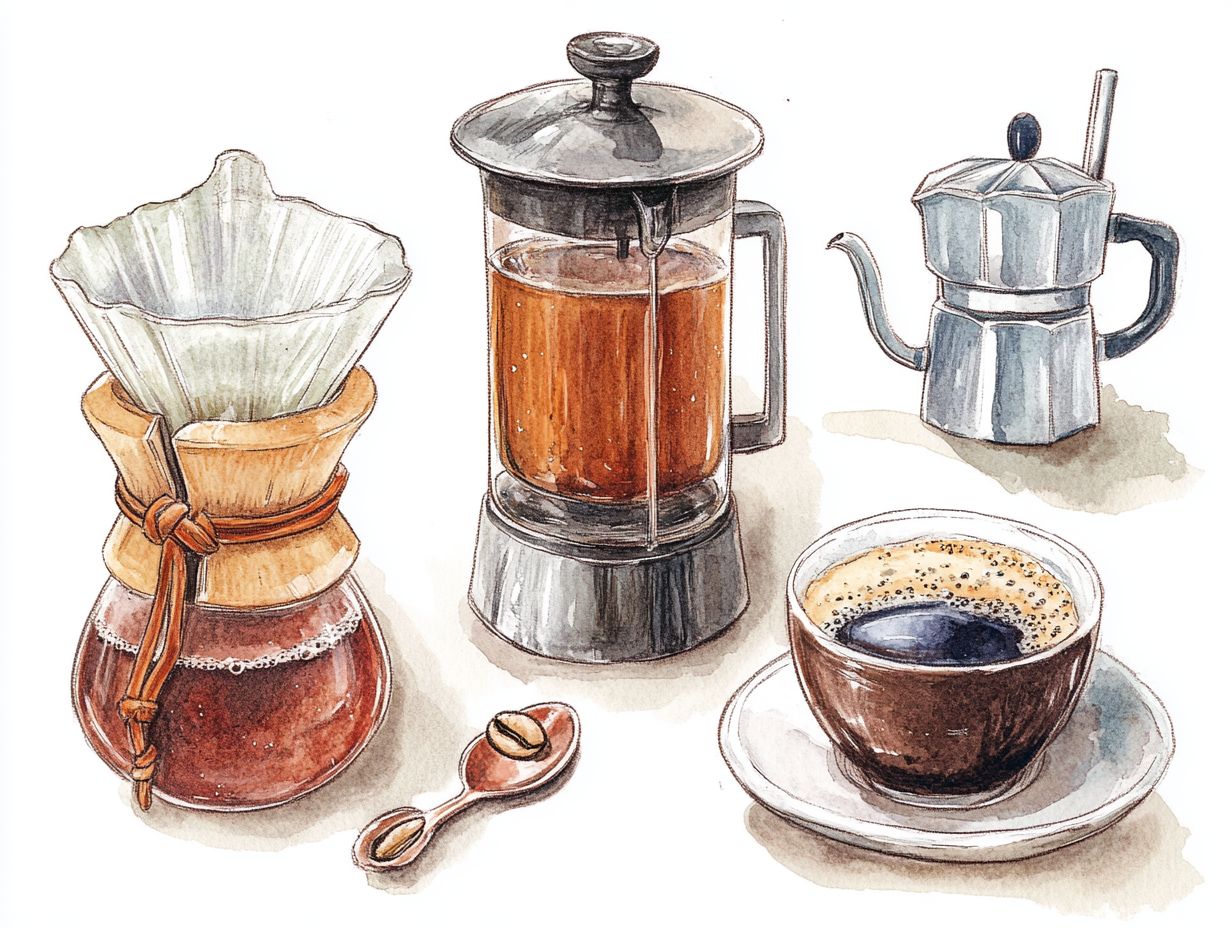
Different brewing methods profoundly affect the strength of your coffee, shaping the extraction of flavors and soluble compounds, which ultimately influences the taste, body, and aroma of your brew.
Whether using an espresso machine or a French press, each method introduces unique variables. These include temperature, contact time, and agitation.
The Specialty Coffee Association provides guidelines for optimal extraction based on these brewing methods. By grasping these distinctions, you can refine your brewing techniques to craft the perfect cup that suits your personal palate.
1. Drip Coffee
Drip coffee stands out as a favored brewing method, known for its simplicity and ability to deliver a consistently enjoyable cup. However, the strength of your brew can fluctuate based on several factors.
One crucial element is the water temperature, which should be between 195 F and 205 F. This range ensures optimal flavor extraction.
If the water is too cold, it can cause under-extraction, resulting in a sour taste. Water that s too hot leads to over-extraction and a bitter cup.
The contact time between the water and coffee grounds typically spans three to five minutes, and this period is vital in shaping the strength and complexity of your final brew. By grasping these variables, you can refine your brewing technique and achieve a more satisfying and harmonious flavor profile in every cup.
Coffee Brewing Methods
2. French Press
The French press method embraces immersion brewing. It allows you to steep coffee grounds in a way that effectively extracts their rich flavors and aromas.
This results in a robust and full-bodied cup that delights the senses. This method is renowned for extracting a high concentration of soluble compounds and essential oils.
This technique hinges on the duration of contact between water and coffee. This is vital for optimal extraction.
Extending the steeping time can elevate the coffee’s strength and complexity. It draws out the essential oils and solubles that give your brew its character.
Fine-tuning the grind size is equally important. A coarser grind helps prevent over-extraction and avoids bitterness.
A finer grind can amplify strength, but be cautious, as it might lead to an abrasive taste if steeped for too long.
Striking the right balance is key to achieving a well-rounded flavor profile.
3. Pour Over
Pour-over coffee brewing is celebrated for its ability to create a clean and crystal-clear cup. It gives you precise control over the extraction variables that shape your coffee’s strength.
The meticulous pour-over method begins with selecting the ideal grind size. This is crucial for optimal extraction.
Opt for a medium-coarse grind; it allows water to flow effortlessly through the coffee bed. This draws out the desired flavors without leading to bitterness.
Temperature plays a key role in this process. Aim to keep your water between 195 F and 205 F.
This range effectively solubilizes the coffee compounds, unlocking their full potential. Your pouring technique can also make a difference.
By using a steady, circular motion, you ensure even saturation of the coffee grounds. This promotes uniform extraction and enhances clarity and sweetness.
By fine-tuning these variables, you can craft a brew that strikes the perfect balance between strength and flavor.
4. Espresso
Espresso is a refined coffee brewing method. It harnesses high pressure to extract vibrant flavors and aromas.
This results in a robust shot that showcases the intense flavor profile of the beans, often made from Arabica or Robusta beans.
This technique involves forcing nearly boiling water through finely ground coffee at around 9 bars of pressure.
The grind size is paramount. Achieving a fine texture is essential for optimal flavor release.
The extraction time typically falls between 25 to 30 seconds. This ensures that the intricate nuances of the coffee are efficiently drawn out.
These meticulous variables combine to create a balanced shot of espresso. It offers a complex experience appreciated by coffee enthusiasts, complete with a luscious crema and a satisfying body.
What Other Factors Affect Coffee Strength?
Several factors significantly impact the strength of your coffee. These include water temperature, brewing time, filtration method, and the freshness of the beans.
Each element can lead to over-extraction or under-extraction of flavors. This ultimately affects the perceived strength and overall quality of your cup.
Pay attention to these details to elevate your coffee experience to new heights.
Unlock the Secrets to Brewing the Perfect Cup of Coffee
Are you ready to unlock the secrets of brewing the perfect cup of coffee? Understanding key factors like water temperature and brewing time can transform your coffee experience!
1. Water Temperature
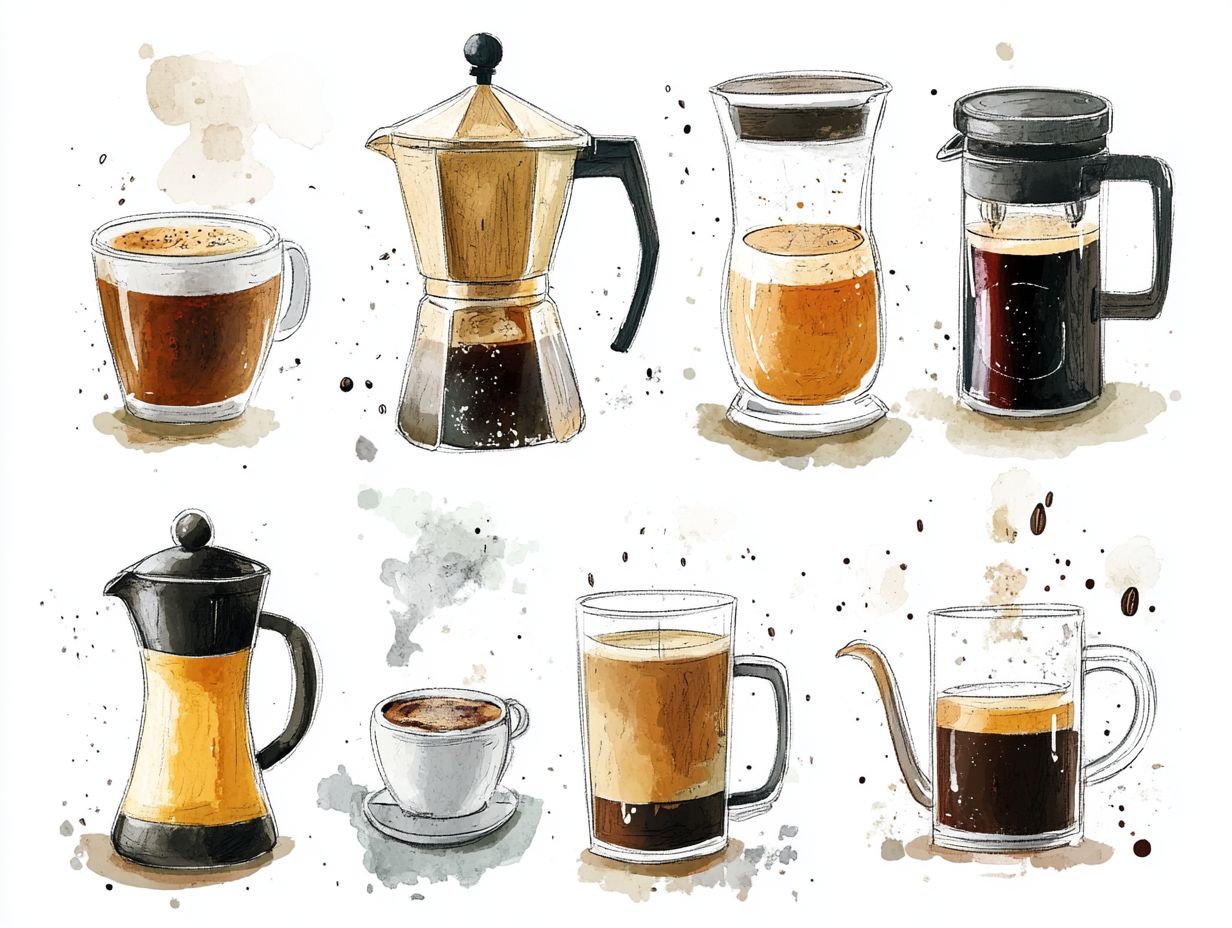
Water temperature is an important part of the coffee brewing process. It directly affects the extraction of soluble compounds and the overall strength of your coffee.
Extraction refers to how well flavors from the coffee grounds are drawn out during brewing. The ideal temperature range for brewing coffee varies based on the method you choose, generally hovering between 195 F to 205 F (90 C to 96 C).
When you use pour-over techniques, maintaining this temperature is crucial for extracting the nuanced flavors from the coffee grounds. This results in a clean and vibrant cup that delights the palate.
If you choose cold brew, you’ll be working with significantly lower temperatures, which can yield a smoother, slightly less acidic flavor profile.
If you’re venturing into the world of espresso, it’s vital to note that using water that’s too hot can scorch the grounds, leading to unpleasant bitterness. Conversely, using cooler water may result in under-extraction, leaving your brew tasting weak and unimpressive.
Striking the right balance is essential for achieving that perfect cup of coffee that you crave.
2. Brewing Time
Brewing time is a critical factor that can significantly impact the strength of your coffee, as it dictates how long the coffee grounds interact with water during the extraction process.
A precisely measured brewing time is essential. If the coffee grounds steep for too short a period, you may end up with a lackluster cup that suffers from under-extraction, resulting in a weak, sour taste devoid of depth and complexity.
On the other hand, letting the grounds brew for too long can lead to over-extraction, producing a bitter, unpleasant flavor as undesirable compounds are drawn out.
Finding the right balance in brewing time is crucial for allowing the richness and aromatic qualities of the coffee to shine through while avoiding the pitfalls of over or under-extraction.
3. Freshness of Beans
The freshness of your coffee beans plays a critical role in the strength and flavor of your brew, particularly for specialty coffee recognized by the Specialty Coffee Association.
As coffee beans age, they start to lose the essential oils and compounds that contribute to a rich and vibrant cup. This degradation can happen within weeks if the beans aren’t stored properly.
Using freshly roasted beans ideally within days of roasting ensures that those delicate oils and nuanced flavors remain intact. This provides you with a more aromatic and full-bodied coffee experience.
Proper storage is key; keeping your beans in an airtight container, away from light and moisture, is essential to preserving their freshness long after roasting. Don t miss out on the amazing flavors that only come with fresh coffee!
How to Adjust Coffee Strength for Different Brewing Methods?
Adjusting the strength of your coffee based on different brewing methods is crucial for achieving that perfect flavor profile and enhancing the overall experience. Whether you’re using a drip coffee maker, French press, or a Hario v60, fine-tuning variables like grind size, water temperature, and brewing time is essential.
By fine-tuning these variables, you can personalize your brew to strike an ideal balance between sweetness and bitterness, perfectly catering to your unique taste preferences.
Conclusion
Understanding the importance of water temperature, brewing time, and bean freshness will help you make the most of your coffee brewing experience. With these tips, you can enjoy a more flavorful and aromatic cup every time.
1. For Drip Coffee
Mastering your coffee strength in a drip coffee maker is exciting and rewarding! To adjust the strength of your drip coffee, you can fine-tune the grind size, water temperature, and brewing time to achieve the flavor and intensity you desire. Begin by paying attention to the initial bloom phase, where the coffee grounds are first saturated with water, allowing gases to escape.
Each of these elements plays a vital role in the extraction process, directly affecting the amount of flavor and aroma released from the coffee grounds. For example, using a coarser grind will yield a milder taste, as it facilitates quicker extraction. A finer grind typically results in a bolder cup.
It s also crucial to pay attention to the water temperature. Brewing with water that s too hot can lead to over-extraction, resulting in bitterness, whereas water that s too cool may under-extract, leaving you with a watery or sour brew.
Adjusting the brewing time is equally significant. Extending the brew time can enhance strength, but you must find the right balance to avoid over-extraction.
By experimenting with these variables, you can discover the perfect brew that aligns with your personal preferences.
2. For French Press
Adjusting the strength of your coffee in a French press is all about mastering the brewing time and the coarseness of your grind, ensuring you achieve that perfect, rich, and flavorful cup. This brew method is renowned for producing strong coffee with a rich flavor.
By experimenting with different brewing times, you can uncover the balance between soaking and extracting that shapes the overall taste. Shortening the brewing duration will yield a milder flavor, while extending it boosts the strength and intensity of your coffee.
The grind size plays a pivotal role; a finer grind increases the surface area, allowing for more robust flavors to be pulled during soaking. Finding the right balance between these factors ultimately leads to a customized coffee experience that aligns perfectly with your personal preferences for strength and richness.
3. For Pour Over
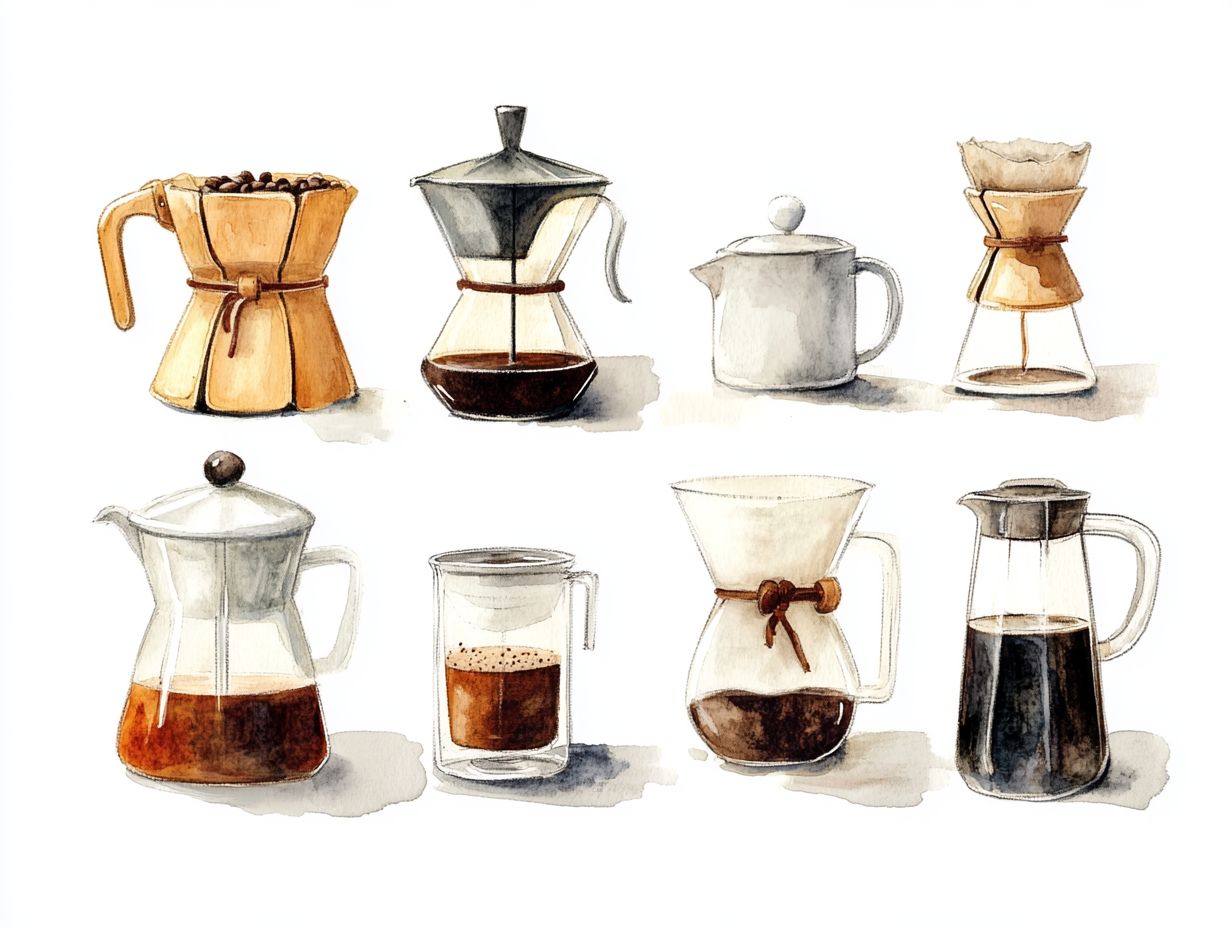
Dive into your coffee-making adventure by mastering the art of water temperature and pouring technique! Regarding pour over coffee, adjusting the water temperature and your pouring technique can greatly influence both the strength and clarity of your brew. Techniques vary, but popular methods like the Hario v60 are favored for their precision and control.
As you explore these variations, you’ll quickly realize just how crucial they are for achieving the perfect extraction. For instance, hotter water tends to extract soluble compounds more rapidly, intensifying the flavors and aromas that dance in your cup. In contrast, cooler temperatures can bring out a brew s brightness and subtle nuances, creating a more complex tasting experience.
Your pouring method whether you opt for a steady spiral motion or a slower, more controlled pour also plays a significant role in the extraction rate, ensuring that your coffee grounds are evenly saturated. By mastering these techniques, you can elevate your pour over experience, crafting a balanced cup that s perfectly tailored to your unique palate.
Espresso Preparation
4. For Espresso
In the art of espresso preparation, you have the power to adjust pressure and extraction time. This allows you to tailor the strength and flavor of your shot to perfection. Monitoring the total amount of substances dissolved in coffee (TDS) can help ensure you achieve the desired strength.
These parameters are important in the brewing process. The pressure you apply directly influences how efficiently water extracts oils and compounds from the coffee grounds.
For example, increasing the pressure results in a quicker extraction, often leading to a bolder and more intense flavor profile. Lowering the pressure might produce a milder taste, offering a different experience altogether. Adjusting the extraction time the duration for which water interacts with the coffee can significantly shift the balance between sweetness and bitterness.
By meticulously calibrating these elements, you can create the perfect espresso tailored just for you! Whether you desire a robust, rich shot or a smoother, more delicate brew, there s a perfect espresso waiting for you.
Frequently Asked Questions About Coffee Brewing
How does the brewing method influence coffee strength?
The brewing method directly affects the strength of coffee by controlling factors such as water temperature, brew time, and extraction ratios. Different methods result in varying levels of extraction, leading to differences in coffee strength.
What is the strongest brewing method for coffee?
The French press is widely considered the strongest brewing method for coffee. It allows for the longest extraction time and uses a fine mesh filter to trap coffee grounds, resulting in a bolder and more full-bodied cup of coffee. This method is ideal for those who enjoy strong coffee.
Does the type of coffee bean affect the strength of coffee?
Yes, the type of coffee bean used, such as Arabica or Robusta, can affect the strength of coffee. Different varieties of coffee beans have varying levels of caffeine and flavor compounds. This can result in differences in coffee strength even when using the same brewing method.
How does a cold brew method affect coffee strength?
Cold brew coffee tends to have a lower strength compared to other brewing methods, like Espresso or French press. This is because the coffee is steeped in cold water for an extended period, resulting in a smoother and less acidic taste.
Can the same brewing method produce different strengths of coffee?
Yes, the strength of coffee can vary with the same brewing method depending on the ratio of coffee to water used. A higher ratio of coffee to water will result in a stronger brew, while a lower ratio will produce a weaker cup of coffee. Different devices, such as the Hario V60, can also influence the strength and TDS of your coffee.
What is the recommended coffee to water ratio for a strong cup of coffee?
The recommended coffee to water ratio for a strong cup is around 1:16, meaning 1 gram of coffee for every 16 grams of water. However, this can vary depending on personal preference, brewing method, and the type of coffee beans used. For precise brewing guidelines, refer to recommendations by organizations like the Specialty Coffee Association.
Experiment with these tips to find your unique coffee strength!

